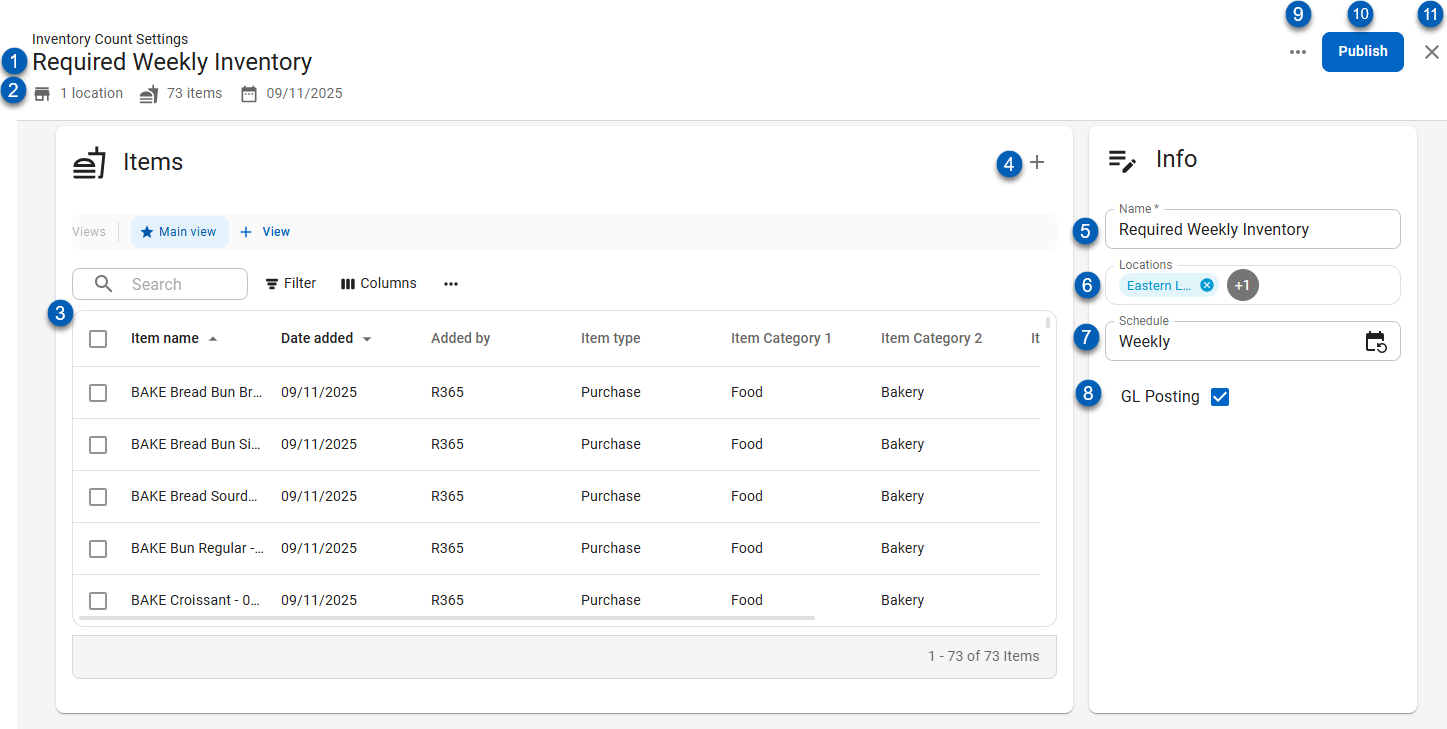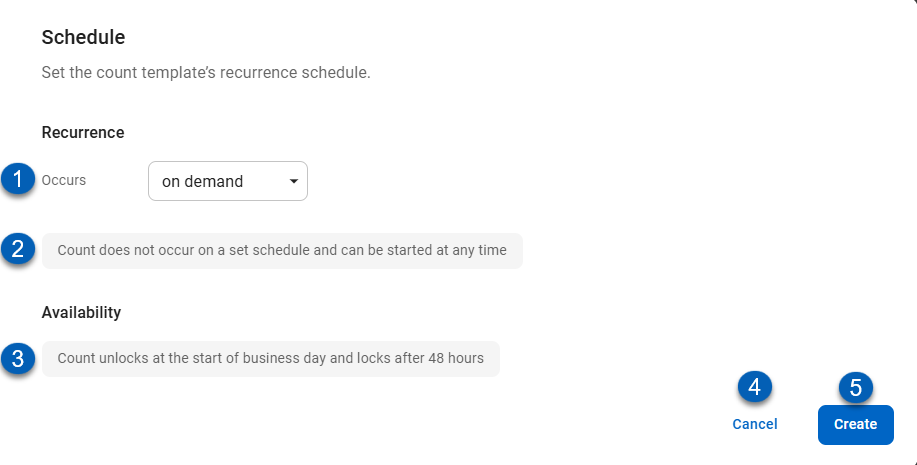This feature is in beta for select customers. Contact your CSM for more information.
This article references the new inventory template experience. Read more about the legacy inventory count template experience.
In R365, Inventory Counts are created from inventory templates. Inventory templates are lists of items to be counted during inventory, with the option to be set to recur on a schedule. They can be created from the Inventory Count Settings page.
Upon creation, inventory templates are given a unique name, assigned to select locations, set for scheduled or on-demand use, and configured to determine whether the template will post to the general ledger (GL). Once the general information is completed, items are added to the inventory template, and the template can be published.
When an inventory count is started, an inventory template must be selected for use. Inventory templates are only available for the locations they are assigned to. On-demand inventory templates can be selected for use on any day. Scheduled inventory templates are available to use on their scheduled days.
The items on the inventory template will fill onto the inventory count and the count can be conducted.
On an inventory count sheet, items are sorted into their assigned storage locations and organized as they are in the storage location manager. Items remain unassigned until they are added to storage locations. Organizing storage locations to match the restaurant’s physical layout makes for more efficient counts. Read more about storage locations.
Learn more about inventory templates:
Security
Permissions
The following permissions are related to inventory templates:
Food
Inventory Count Templates
View Inventory Count Templates
Edit Inventory Count Templates
Edit Inventory Template General Details
Edit Template GL Posting Status
Edit Template Count Schedule
Edit Items/Recipes
Add Items/Recipes
Remove Items/Recipes
Create Inventory Count Templates
Delete Inventory Count Templates
These permissions can be added to custom user roles or individual users. The Permission Access report can be used to determine which user roles or users already have these permissions assigned. For more information, see User Setup and Security.
Location Access
In addition to required permissions, access to view and edit is determined by location access.
Users with access to all locations on an inventory template:
Can view the template
Can edit the template
Users with access to only one or some locations on an inventory template:
Can view the template
Users cannot edit templates with locations they do not have access to.
Navigation
Open the Inventory application.
Expand Inventory.
Select Inventory counts.
Click the gear button to open the Inventory Count Settings.
To open an inventory template, select an existing template from the list or click the Create button to open a new template.

Inventory Template Page

Fields | Description | |
|---|---|---|
1 | Inventory Template Overview | Overview details of the inventory template, including the following:
|
2 | Items List | List of items on the inventory template. The items are listed with the following details:
|
3 | Add Item | Opens the Add Items panel. From this panel, items can be added to the inventory template. |
4 | Inventory Template Name | Name given to the inventory template. This can be edited at any time. |
5 | Assigned Locations | Locations and location groups assigned to the inventory template. The inventory template will be available for use at the locations in this field. |
6 | Schedule | The template’s recurrence schedule, if any. Templates can be scheduled by week, period, or only be used on demand. Clicking this field in creation or on an existing template will open the Schedule window. Read more about this window below. |
7 | GL Posting | Indicates whether the items on counts created using this template will post to the general ledger (GL). GL posting inventory counts are recorded as transactions that affect financial reports and accounting.
|
8 | Menu | Opens the inventory template menu. From this menu, the following actions can be taken:
|
9 | Publish | Publishes any changes made to the inventory template. |
10 | Close | Closes the inventory template. |
Schedule Window
When the Schedule field is clicked, it will open the Schedule window where the schedule can be configured.

Field | Description | |||||||
|---|---|---|---|---|---|---|---|---|
1 | Occurs | The template set recurrence. The selector features the following selections:
| ||||||
2 | Recurrence Description | Describes how often the schedule is set to recur based on the selections made above. | ||||||
3 | Availability | Describes when the count will be available to start. For scheduled templates, the system implements a 48-hour availability window that begins at a location’s Start of Day on the scheduled day and closes 48 hours after. | ||||||
4 | Cancel | Closes the Schedule window without changing the configuration. | ||||||
5 | Create | Applies the schedule settings . |
Create and Edit Inventory Templates
Inventory templates can be created by clicking the Create button on the Inventory Count Settings page. After creation, they can be edited or modified as needed. Learn more about creating and editing inventory templates.
Inventory Count Settings Page
The Inventory Count Settings page lists all existing inventory templates. Templates can be created and accessed from this page. Read about the Inventory Count Settings page.
Scheduled Inventory Counts
Inventory templates can either be scheduled or marked as on demand. Read more about scheduled inventory counts.

